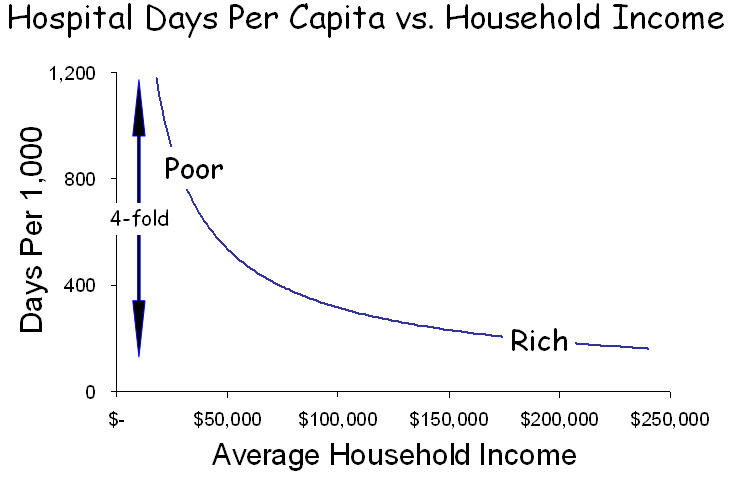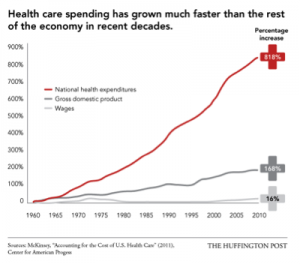Abstract
Income elasticity of demand for the health care services represents the correlation of the quantity of products or services demanded by the population and the alterations in the individual income of the population. As health care services are a necessary good for any human beings, they tend to show lower or no price and income elasticity of demand.
Introduction
Over the last several decades, multiple researchers focused on the changes in the demand for health care services and their differences around the world. The correlation of the costs and the demand for this kind of services has been researched from the perspectives of various contributing factors. Besides, the scholars have been using a variety of methods attempting to conduct accurate estimations of income elasticity of demand. In this paper, income elasticity of demand is explained as an economic concept within health care field. Moreover, this paper focuses on the income elasticity of demand tendencies across the world and the quality of the health care services in the United Arab Emirates namely.
Income Elasticity of Demand
Income elasticity of demand is applied in a variety of fields apart from health care. Income elasticity of demand is referred to two main variables that are the quantity of products or services demanded by the population in a particular market and the alterations in the individual income of the population. It is called elasticity because the correlation between the two variables mentioned above can be rather flexible. One factor responds to the change of the other. In other words, the more the consumers earn, the more they are able to spend on products or services and the other way around. In order to estimate the income elasticity of demand, one is to divide the percentage of the amount of demanded services or goods by the percentage of the consumer income change.
The character of change in the income size and the population’s response through the purchasing tendencies indicates whether they treat the studied goods or services as a necessity or as a luxury. The demand for both necessity and luxury commodities will become higher as the personal income of the population grows. At the same time, the demand for the luxury goods and services stands out due to the slower response to the increase in the consumer income. This relationship may be illustrated my means of a simple example: comparing the population’s demand for food and for smartphones it is easy to notice which one of these goods is a necessity and which is a luxury. As an individual’s income growth they would be more likely to spend more on food (necessity goods), and when it comes to smartphones, even an individual able to afford it will only go for such purchase in some cases. That way, under the impact of income growth the demand for this luxury good will respond slower than the demand for food.
Empirical Evidence about the Income Elasticities of Demand for Health Care Services across Countries
First of all, discussing income elasticities of demand for health care services it is important to notice that essentially, the health care services are a necessity by nature. It is quite normal for a human being to fall ill from time to time, get injured, and need medical help. At the same time, the prices for health care services in a multitude of countries all over the world (both developed and developing) are often so high that medical services are forced into the category of luxury goods. The study by Zhou, Su, Gao, Xuc, and Zhang (2011) targeting China, maintains that due to the responsiveness of the population’s demand for the health care services to their cost can be used as a base for policy to adjust the demand for some services through providing a compensation or insurance opportunities for the citizens.
Besides, Morris, Devlin and Parkin (2007) discussed the factors that influenced the demand for the demand for the private medical insurance in the United Kingdom. Interestingly, the authors note that the citizens of the UK are provided with free medical care services delivered by the NHS as soon as they are needed, yet fifteen percent of the population of the UK still purchases private insurance (Morris et al., 2007). The main factor contributing to this phenomenon is the quality of the NHS performance in various regions of the state, namely, the amount of time the patients have to wait for their care.
Analyzing a variety of cross-national studies focused on the income elasticities of demand for health care services, Nyman (2003) notices that the fact that some consumers receive insurance payoffs due to the coverage of some of their medical expenditures “does not merely cancel the exogenously determined income loss, but instead generates additional consumption of medical care” (p. 23).
What Can Be Concluded
Based on the knowledge obtained from various scholarly sources written by the authors from all around the world one may see that the demand for health care, in general, does not show any significant elasticity that would be influenced by price or income (Costa-Font, Gemmill, & Rubert, 2009; Martinez-Giralt, & Barros, 2013). As a result, it is still quite difficult to determine whether health care services should be characterized as the necessity or luxury goods. At the same time, some of the fields of health care have higher price elasticities than the other. An example of a sphere with higher price elasticity is preventative care that is easy to replace with numerous measures such as regular exercise, healthy diet, and nutritional supplements (Martinez-Giralt, & Barros, 2013). These substitutes are also not cheap and are only available to the wealthier groups of the population while the low-income ones are simply forced to ignore preventative care due to their inability to afford it or its alternatives. As a result, a tendency illustrated in Figure 1 is observed – the poorer populations end up falling ill and using health care services more often.
Moreover, Figure 2 demonstrates the proportional difference between the changes in the costs spent by the US citizens on health care and their wages as well at the country’s GDP growth in general. Based on the crucial difference between the growth rates of the three factors it is possible to conclude that health care services remain in high demand regardless of the population’s income. As a result, one may state that health care services should be characterized as a necessity good.
Health Care Quality in the UAE
Over the decades of the UAE’s independence from Britain, the country has managed to improve its economy, the quality of life of its native population, its trade, and international relations. Through the fast expansion of the UAE’s cities, the population of the country grew as well, and so did the demand for the health care services. As stated by the UAE’s Federal National Council, the main challenges faced by the healthcare system of the country are the insufficient number of hospitals and beds for the fast-growing population, skill shortage in a number of medical specialties, and the growth of the rates of chronic diseases such as hypertension and diabetes in the resident population (Harrah, 2014). Besides, just like in most world’s countries, the cost of health care services in the UAE remains extremely high regardless of all the plans and programs the state leaders enforce to keep the prices down through a set of discounts, insurances, and free services (Harrah, 2015).
At the same time, the UAE healthcare system provides all of the country’s residents with medical insurance (foreign workers included). The level of the healthcare system quality in the UAE overall is rated higher than that of the United States (Harrah, 2014). The Emirates are currently struggling with the problem of shortages of hospitals and medical professionals that is complicated by a large number of expatriates dwelling in the country that are often in need of medical care.
Recommendations
The use of preventative care that is often omitted as an income elastic sphere requires the attention of policy makers since this is the sphere of healthcare that is the most cost-effective for both the patients and the government in the long-term. Affordable preventative care will help the low-income populations to reduce the number of their visits to the doctors and make other areas of healthcare more responsive to the income level in the society switching the luxurious prices of this necessity service to more adequate ones.
Conclusion
Healthcare systems all over the world are struggling with similar problems such as the growing costs of the medical services that do not correspond to the domestic wages or GDP growth. Since medical care is a natural need of any human being, it is treated as a necessity good by the population, meaning that it will be in high demand regardless of the personal income of the individuals. In fact, the poorer populations need more medical care than the richer ones. At the same time, some of the health care areas have more income and price elasticity mainly because they are replaceable with the alternative health protection means.


Reference List
Costa-Font, J., Gemmill, M., & Rubert, G. (2010). Biases in the healthcare luxury good hypothesis?: a meta-regression analysis. Journal of The Royal Statistical Society: Series A (Statistics In Society), 174(1), 95-107.
Harrah, S. (2014). Health Care around the World: United Arab Emirates. Web.
Martinez-Giralt, X., & Barros, P. (2011). Health Economics. Hoboken, NJ: Taylor & Francis.
Morris, S., Devlin, N., & Parkin, D. (2007). Economic analysis in health care. Chichester, UK: J. Wiley & Sons.
Nyman, J. (2003). The theory of demand for health insurance. Stanford, CA: Stanford University Press.
Zhang, L. (2013). Income Growth and Technology Advance: the Evolution of the Income Elasticity of Health Expenditure. 14th EHEW, 1-42.
Zhou, Z., Su, Y., Gao, J., Xu, L., & Zhang, Y. (2011). New estimates of elasticity of demand for healthcare in rural China. Health Policy, 103(2-3), 255-265.